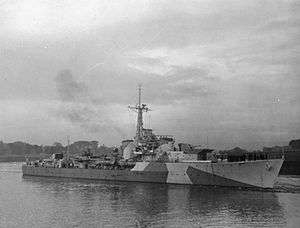HMS Caesar (R07)
 | |
| History | |
|---|---|
| Name: | HMS Caesar |
| Ordered: | 16 February 1942 |
| Builder: | John Brown, Clydebank |
| Laid down: | 3 April 1943 |
| Launched: | 12 February 1944 |
| Completed: | 3 October 1944 |
| Commissioned: | 17 July 1944 |
| Recommissioned: | 1960 |
| Decommissioned: | 1965 |
| Renamed: |
|
| Identification: | Pennant number: R07 initially, but changed to D07 in 1945 |
| Motto: | Veni, vidi vici |
| Honours and awards: | Glorious First of June 1794 - Cut of Gibraltar 1801 - Strachan's Action 1805 - Basque Roads 1809 - Walcheren 1809 - Baltic 1854 |
| Fate: | Arrived at breaker's yard Hughes Bolckow for scrapping, 6 January 1967 |
| Badge: | On a Field Blue. the head of Caesar, gold. |
| General characteristics | |
| Class and type: | C-class destroyer |
| Displacement: | 1,710 tons (standard) 2,520 tons (full) |
| Length: | 363 ft (111 m) o/a |
| Beam: | 35.75 ft (10.90 m) |
| Draught: |
|
| Propulsion: |
|
| Speed: | 37 knots (69 km/h) |
| Range: | 615 tons oil, 1,400 nautical miles (2,600 km) at 32 knots (59 km/h) |
| Complement: | 186 |
| Armament: |
|
| Aircraft carried: | None |
HMS Caesar was a C-class destroyer of the Royal Navy, ordered on 16 February 1942. She was originally to be named HMS Ranger but this was changed to Caesar before launch to fit her revised class name. She was the sixth British warship to have had this name. She was built as a flotilla leader with additional accommodation for staff officers.
Wartime service
On commissioning in September 1944 Caesar was allocated to the 7th Destroyer Flotilla for service with the Home Fleet and took part in the Atlantic convoys. In 1945 she was allocated for service in the Far East at the close of the Second World War, but joined the Fleet at Trincomalee after VJ-Day.[1]
Post war service
Following the war Caesar paid off into reserve. Along with other Ca group destroyers, she was selected for modernisation which was completed at Rosyth between 1957 and 1960. Work included a new enclosed bridge and Mark 6M gunnery fire control system, as well as the addition of two triple Squid anti-submarine mortars. She re-commissioned in September 1960 as leader of the 8th Destroyer Squadron with most of her service performed in the Far East.[2] This included service in the Indonesian Confrontation.
Decommissioning and disposal
Caesar was paid off in June 1965 and was de-equipped at Chatham.[3] She was subsequently sold to Hughes Bolckow, arriving at their breaker's yard at Blythe for scrapping on 6 January 1967.
References
- ↑ Mason, Geoffrey B. (2004). Gordon Smith, ed. "HMS Caesar (R 07) - Ca-class Destroyer". naval-history.net. Retrieved 20 May 2015.
- ↑ Marriott, Leo (1989). Royal Navy Destroyers Since 1945. Ian Allen Ltd. pp. 57–62.
- ↑ Critchley, Mike (1982). British Warships Since 1945: Part 3: Destroyers. Liskeard, UK: Maritime Books. p. 90. ISBN 0-9506323-9-2.
Publications
- Colledge, J. J.; Warlow, Ben (2006) [1969]. Ships of the Royal Navy: The Complete Record of all Fighting Ships of the Royal Navy (Rev. ed.). London: Chatham Publishing. ISBN 978-1-86176-281-8. OCLC 67375475.
- Marriott, Leo (1989). Royal Navy Destroyers Since 1945. Ian Allen Ltd. ISBN 0-7110-1817-0.